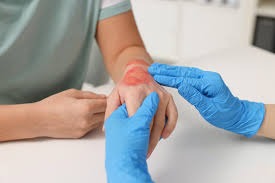When it comes to managing wounds, whether they are minor abrasions or more significant lacerations, the principles of effective care are critical in promoting quick and proper healing. Understanding the fundamentals of wound care is essential to prevent complications such as infections or delayed healing, which can lead to further health issues.
Wound management is a multifaceted process that involves a clear understanding of the wound healing stages, choosing the appropriate products and techniques, and having the patience and knowledge to see the process through to completion.
Understanding the Wound Healing Process
The body’s natural wound healing process consists of an orderly sequence of events that work to repair the damaged skin and tissues. These events are typically categorised into four key stages: hemostasis, inflammation, proliferation, and maturation. Each stage is crucial, and disrupting this process can lead to improper or delayed healing.
During the hemostasis phase, the body acts to stop the bleeding through clotting mechanisms. This is followed by the inflammation stage, where the body’s immune system begins to clear the wound of any debris or bacteria. The proliferation stage is where new tissue and blood vessels begin to form, leading to the final maturation stage where the wound remodels and strengthens.
Selecting the Right Wound Care Products
Choosing the appropriate SuperPharmacyPlus wound care products is vital in ensuring an optimal healing environment. These products range from simple plasters and gauze to more advanced dressings that maintain moisture levels and protect against bacterial invasion. Each type of wound may require a different product to promote adequate healing.
For example, a dry wound might benefit from a hydrogel dressing, which provides moisture and facilitates the movement of epidermal cells, while an exuding wound may require an absorbent dressing that can manage the excess fluid.
Keeping the Wound Clean
Cleaning the wound is an integral part of the healing process. It reduces the risk of infection and helps to ensure that the healing stages can progress without interruption. Proper cleaning involves gently rinsing the area with water and a mild soap to remove any foreign material, followed by the application of an appropriate antiseptic if required.
Care must be taken to avoid any harsh scrubbing as this can damage the new tissues forming during the proliferation stage. After cleaning, the wound should be carefully dried to prevent maceration of the surrounding skin.
Creating an Optimal Healing Environment
The environment in which a wound heals can significantly impact the speed and quality of recovery. This includes the external conditions around the wound as well as the internal environment created by the body’s own healing mechanisms.
Keeping the wound moist but not excessively wet is important, as dry wounds can lead to scabbing, which might slow down healing. Conversely, too much moisture can cause skin breakdown around the wound edges. This balance is often maintained by the appropriate choice of dressings, which can either donate moisture or absorb excess fluid.
Maintaining Good Nutrition
Nutrition plays a pivotal role in wound healing. The body requires a range of nutrients, including protein, vitamins A and C, and minerals such as zinc, to support the healing process. A well-balanced diet can provide these essential nutrients, which are necessary for the formation of new tissues and immune function.
People with wounds should consider their dietary intake carefully and may benefit from consulting a healthcare professional or a dietician if they are unsure about their nutritional needs during the healing process.
Monitoring and Assessment
Regular monitoring and assessment of the wound are required to ensure that it is healing at an appropriate rate. This involves observing the wound for signs of infection, such as increased pain, redness, swelling, or a discharge that is thick and may have an odour.
If any signs of infection are present, or if the wound does not appear to be healing as expected, it is crucial to seek professional medical advice. Timely medical intervention can prevent complications and get the healing process back on track.
Conclusion
Effective wound care is a delicate balance of practicing good hygiene, choosing the right wound care products, maintaining a wholesome diet, and monitoring for any signs of abnormal healing. By adhering to these principles and fostering a conducive healing environment, individuals can support their bodies’ natural healing processes and achieve better outcomes.
For those looking to source high-quality care essentials, an extensive array of SuperPharmacyPlus wound care products is available to cater to various wound types and needs, providing the necessary tools to aid in quick and efficient healing. Remember, while taking care of wounds at home is possible for minor injuries, seeking proper medical advice is crucial for more serious wounds or any concerns about infections or healing difficulties.
Empowered with knowledge and the right products, effective wound care is within the reach of anyone aiming to heal wounds promptly and avoid potential complications. Taking an active role in the wound healing process is paramount to achieving optimal outcomes and minimising any long-term impacts that may arise from poorly managed wounds.
READ MORE : What To Know Before Opening A Bank Account In The UAE?
